#Infantry Day 2022
Text
Video: Indian Army celebrates 76th Infantry Day
Video: Indian Army celebrates 76th Infantry Day
#India #IndianArmy #army #defence #defense #infantry #infantryday2022 #video #defencenews #defencestar @pmoindia @defenceminindia @rajnathsingh @adgpi @iaf_mcc @indiannavy @drdo_india
Indian Army Infantry Day 2022 Video: Indian Army, which is the world’s second largest standing army, celebrates Infantry Day on October 27 every year to commemorate the success of Indian Infantry soldiers in driving out the Pakistani intruders from Kashmir.
The first troops of Indian Army had landed at Srinagar Airport on October 27, 1947 when the Pakistani intruders were had reached on the…

View On WordPress
0 notes
Text
Daily update post:
A terrorist in the PIJ (Palestinian Islamic Jihad) has admitted in his interrogation that they practiced for the Oct 7 massacre on Iranian soil. This is important to remember, that it wasn't just Hamas that committed the vicious attack on Israelis during that day, that the Islamist regime in Iran's involvement was crucial to what happened, and that Gaza was NEVER "an open air prison" as the anti-Israel crowd claimed. The above link has the vid quoted here.

Yesterday, Golani infantry's division 36 has left a section in northern Gaza, as a part of lowering the intensity of the fighting there. A short while later, no less than 50 rockets were fired from exactly that area into southern Israel. Yoram Bitan's shop in the southern town of Netivot took a direct hit from a rocket while he and his son were still inside (pic is from this vid, where the start also shows the barrages of rockets over Netivot). They're both thankfully okay, the building absorbed most of the impact.

Just this morning, at least 25 more rockets were fired from that area of Gaza into Israel, before IDF soldiers managed to find and destroy some of the rocket launchers that were used in these attacks (see pic with just one barrage of intercepted rockets over Israel on the horizon, Hebrew source). If Israel can't lower the intensity of the fighting, that's absolutely also because of Hamas' continued choices. Israeli civilians from the south are currently protesting against the possibility that Israel will stop the war before the complete removal of the threat of rockets being fired from Gaza.

The IDF has confirmed yesterday that it has eliminated more than 150 Hezbollah squads since the start of the war.
I got to watch an interview with Shirley (not necessarily her real name), who was a prison guard where Palestinian terrorists were held. She was sexually harassed by a terrorist called Muhammad Atallah for 2 years. Towards the end of her service at this prison, he told her that her life is being threatened by Amjad Awad, a Palestinian terrorist, who murdered the Fogel family when he was 18 years old, together with his relative, 17 years old Hakim Awad. These are 35 years old Ruti, 36 years old Udi, 11 years old Yoav, 4 years old Elad and 3 months (!) old Hadas in Mar 2011. Amjad and Hakim were actually on their way out of the house, when they heard baby Hadas crying in her crib, returned and murdered her (Hebrew source).
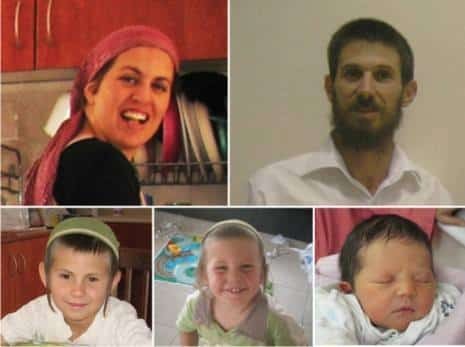
You can hopefully understand why Shirley was terrified when she heard Awad wanted to kill her, and Atallah claimed he could keep her safe, using this to try and rape her in a spot between two gates in the prison where there are no cameras. She fought back and saved herself. Atallah, who is imprisoned for attempted murder and murder as part of his terrorist activity, was put on trial back in 2022 for sexual harassment of Shirley and attempted rape, as well as for raping another female prison guard.
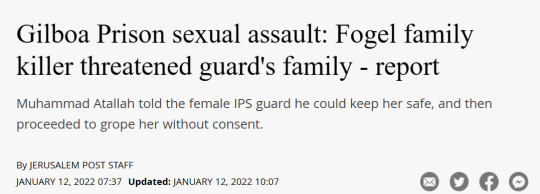
But in the interview I listened to yesterday, Shirley talked about how horrified she is over the possibility that Awad and Atallah might be freed in a hostage deal, where Hamas will demand terrorists with "blood on their hands" be released.
Last night, the IDF presented the findings of an investigation into the cause of death of 3 hostages, whose bodies were retrieved from Gaza. The autopsy determined that they were NOT killed by direct IDF or terrorists fire, but the bodies are in such a state, that it's impossible to determine what did kill them.

These are Michal and her husband Alex Lubnov.
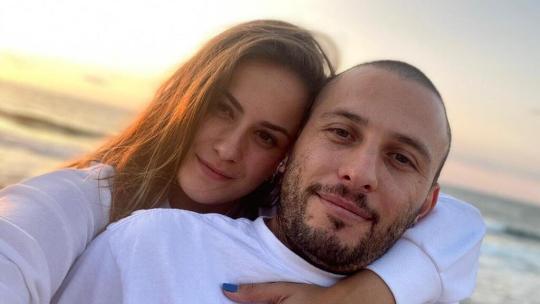
Alex worked as a bartender at the Nova music festival on Oct 7. He was kidnapped to Gaza. Michal is seven months pregnant. This week, she visited the site from which Alex was kidnapped for the first time. She's waiting for her husband to be freed, and be with her at the delivery room.
(for all of my updates and ask replies regarding Israel, click here)
#israel#antisemitism#israeli#israel news#israel under attack#israel under fire#israelunderattack#terrorism#anti terrorism#hamas#antisemitic#antisemites#jews#jew#judaism#jumblr#frumblr#jewish
266 notes
·
View notes
Text
April 7, 2024: The First Line is the Deepest, Kim Addonizio
The First Line is the Deepest
Kim Addonizio
I have been one acquainted with the spatula,
the slotted, scuffed, Teflon-coated spatula
that lifts a solitary hamburger from pan to plate,
acquainted with the vibrator known as the Pocket Rocket
and the dildo that goes by Tex,
and I have gone out, a drunken bitch,
in order to ruin
what love I was given,
and also I have measured out
my life in little pills—Zoloft,
Restoril, Celexa,
Xanax.
I have. For I am a poet. And it is my job, my duty
to know wherein lies the beauty
of this degraded body,
or maybe
it's the degradation in the beautiful body,
the ugly me
groping back to my desk to piss
on perfection, to lay my kiss
of mortal confusion
upon the mouth of infinite wisdom.
My kiss says razors and pain, my kiss says
America is charged with the madness
of God. Sundays, too,
the soldiers get up early, and put on their fatigues in the blue-
black day. Black milk. Black gold. Texas tea.
Into the valley of Halliburton rides the infantry—
Why does one month have to be the cruelest,
can't they all be equally cruel? I have seen the best
gamers of your generation, joysticking their M1 tanks through
the sewage-filled streets. Whose
world this is I think I know.
--
Poetry nerd extra credit: How many repurposed bits from famous poems can you find? I count 7 and I'm probably missing some!
Also by Kim Addonizio:
+ For Desire
+ Mermaid Song*
+ Onset
+ My Heart
* (Weird fact: this is about her daughter, Aya Cash, who starred in the sitcom You're the Worst. What!)
Today in:
2023: Insha’Allah, Danusha Laméris
2022: To the Woman Crying Uncontrollably in the Next Stall, Kim Addonizio
2021: You Mean You Don’t Weep at the Nail Salon?, Elizabeth Acevedo
2020: Let Me Begin Again, Philip Levine
2019: Hammond B3 Organ Cistern, Gabrielle Calvocoressi
2018: Siren Song, Margaret Atwood
2017: A Sunset, Ari Banias
2016: Coming, Philip Larkin
2015: The Taxi, Amy Lowell
2014: Winter Sunrise Outside a Café Near Butte, Montana, Joe Hutchison
2013: The Last Night in Mithymna, Linda Gregg
2012: America [Try saying wren], Joseph Lease
2011: Boston, Aaron Smith
2010: How Simile Works, Albert Goldbarth
2009: Crossing Over, William Meredith
2008: The World Wakes Up, Andrew Michael Roberts
2007: Hour, Christian Hawkey
2006: For the Anniversary of My Death, W.S. Merwin
2005: The Last Poem About the Snow Queen, Sandra M. Gilbert
21 notes
·
View notes
Text
By SAM SOKOL
Members of an all-female tank crew that ran down dozens of Hamas terrorists on October 7 are proud of themselves and are eager for further combat operations, Lt. Michal Ohana, an officer in the Caracal mixed-gender light infantry battalion, tells lawmakers.
Testifying in the Knesset at a conference on the topic of “Women’s Heroism in the War,” the 21-year old tanker declares that her soldiers “felt a crazy significance” after the battle, are “proud of themselves” and “want more.”
The soldiers are part of a company of all-women tank operators, which was made permanent in the Israel Defense Forces in 2022 after a two-year pilot program. The company usually operates along the Egyptian border — not in wars or in fighting behind enemy lines.
On the morning of October 7, Ohana and her fellow soldiers left their base at Nitzana and drove north as fast as they could, in tanks and an armored Humvee. In one of a number of highly irregular decisions IDF commanders were forced to make that day, the tanks were given the okay to drive on civilian roads — at speeds far higher than recommended.
Speaking to Channel 12 in November, Ohana recalled how she “saw terrorists everywhere, and I told the driver — just run them down.”
In response, IDF Chief of Staff Herzi Halevi declared that their actions had silenced any doubters over the ability of women to be in combat units. Since October 7, the army reports that it has seen a massive spike in female conscripts seeking to join combat units.
Lawmakers and bereaved parents last month demanded an investigation into the IDF’s apparent disregard for the warnings of the female surveillance soldiers tasked with watching the Gaza border in the weeks before the Hamas massacre.
17 notes
·
View notes
Text
Public discussions following Vladimir Putin's May visit to China largely focused on exports of obscure tubers and beef cartilage to Beijing. But despite the lack of a public breakthrough in the sphere of military assistance, China remains an essential partner for the Kremlin in its war in Ukraine. Military supplies from other allied authoritarian regimes — North Korea, Iran, and Belarus — sometimes even surpass those Ukraine receives from the West. As Russia’s own reserves of armored vehicles dwindle, support from the Kremlin’s axis of authoritarian allies is only expected to grow.
Belarus: A launchpad for attacks, training of mobilized troops, tanks, and fuel
For the first six years of Russia’s war in Ukraine — i.e. 2014-2020 — Alexander Lukashenko's regime in Minsk managed to maintain a relatively independent policy. There was even limited military-technical cooperation between Belarus and Ukraine, with Belarusian petroleum products refined from Russian oil going to Ukraine for use by its armed forces at a time when they were busily fending off attacks from Russian-backed forces in the Donbas region. However, everything changed in August 2020, when a wave of popular protests swept over Belarus, exposing Lukashenko’s political vulnerability at home. Vladimir Putin responded by allocating a reserve of Russian law enforcement officers to suppress the demonstrations, thereby maintaining the regime in power in Minsk while leaving it almost wholly dependent on Moscow for survival. In February 2022, it was time for Lukashenko to repay his debts by becoming an accomplice, if not an outright ally, in the Kremlin’s full-scale assault on Kyiv.
In the early days of the invasion, forces from Russia's Eastern Military District and Airborne Troops, which had relocated to Belarus under the pretext of conducting training exercises, thus securing a foothold on the right bank of the Dnieper River, launched an offensive on the Ukrainian capital. Kyiv’s main government buildings and other “decision-making centers” are located on the right bank (the western one), an area of Ukraine that became accessible to Russian invaders largely thanks to the fact that they were able to stage their attack from Belarusian territory. Furthermore, Belarus became a reliable rear base for the Russian army, which received fuel and lubricants directly from the Mozyr refinery, had its wounded soldiers treated in Belarusian hospitals, and launched missile attacks and airstrikes from Belarusian soil and airspace.
Notably, Ukraine refrained from striking Belarusian territory, likely to avoid provoking Lukashenko into direct participation in the war. As a result, Russian troops in Belarus felt even safer than in Russia's border regions, which were subjected to Ukrainian strikes from the first days of the full-scale invasion. Without this “immunity,” the losses suffered by the Russian side during its retreat from the Kyiv region in March-April 2022 might have been even greater. Even after the Russian withdrawal, Belarusian airspace was used by Russian A-50 AWACS aircraft, Tu-22M3 strategic bombers, and Su-34 and Su-35 fighters to launch airstrikes.
The next phase of cooperation between Moscow and Minsk began at the end of 2022. The Belaruski Hayun monitoring group reported the dispatch to Russia of trains carrying dozens of tanks (1, 2), trucks, and ammunition from Belarusian warehouses. According to the group’s estimates, in October 2022 alone, 98 T-72 tanks, 60 BMP-2 infantry fighting vehicles (including 20 without turrets), and 53 Ural trucks were shipped. As of early November 2022, over 65,000 tons of ammunition had been transferred.
With the start of Russia’s mobilization in September 2022, some groups of recruits, primarily reinforcements for the 2nd Guards Motor Rifle Taman Division, received training at Belarusian ranges due to overcrowding at Russian sites. Economic aid has also played a crucial role: in recent months, imports of gasoline from Belarus have helped the Kremlin stabilize consumer prices amid drone attacks on its own refineries. Additionally, it was recently disclosed that the Belarusian military-industrial complex produces sights for Russian APCs, and also for its T-72 and T-90 tanks.
Of course, this help comes at a cost. Despite the Russian army’s acute need for military equipment, weapons deliveries to Belarus continue, albeit with significant delays. Additionally, Russian tactical nuclear weapons were recently stationed in Belarus, likely easing Lukashenko's concerns about “threats from NATO.” Furthermore, Russian police and National Guard officers remain ready to assist the Minsk regime in the event of renewed protests.
It should be noted that Belarusian capabilities to provide military aid to Russia are far from exhausted. The country produces “Kaiman“ armored vehicles, MAZ military trucks, and MZKT chassis for heavy equipment. Additionally, the Belarusian military industry complex manufactures reconnaissance drones and multiple launch rocket systems, and it also upgrades tanks. These resources could prove indispensable for the Russian army, which is experiencing a significant shortage of certain equipment (specifics of which can be found in our front-line situation review).
Iran: Drones and artillery ammunition
Russian-Iranian military-technical cooperation dates back to the late Soviet era, when Moscow sent Tehran modest arms and equipment supplies during the Iran-Iraq War (1980–1988). After the Soviet Union’s collapse, military shipments to Iran increased until they were almost completely halted between 2008-2015 due to international sanctions imposed on Iran’s nuclear program. Notable deals include the transfer in 2007 of Tor surface-to-air missile systems, one of which accidentally shot down a Ukrainian International Airlines commercial flight over Tehran in 2020. Additionally, Iran and Russia cooperated militarily in Syria to support the regime of Bashar al-Assad in the country’s civil war.
Almost from the outset of the Russia-Ukraine war, the Kremlin needed military aid. Moscow was particularly interested in Iran's advanced drone industry. Under sanctions and unable to procure full-fledged combat aircraft, the Iranian regime developed an impressive range of drones, from reconnaissance platforms to loitering munitions. While the Russian military industry excelled in reconnaissance UAVs, Russia had almost no kamikaze drones at the beginning of the full-scale war. As pre-war missile stockpiles were gradually depleted, the focus shifted to long-range drones like Shahed-131 and Shahed-136.
Because of these drones, along with cruise and ballistic missiles, it became significantly more challenging for the Ukrainian Armed Forces to fend off attacks on both civilian and military infrastructure behind the front lines. Consequently, production of Shahed drones shifted to Russia itself at sites like the Alabuga Special Economic Zone, often utilizing forced student labor. According to agreements disclosed in 2022 through leaked documents from Alabuga, Iran committed to supplying 6,000 kits for assembling Shaheds over two and a half years.
Russian-made drones underwent significant modifications: Kometa-M antennas were installed to counter electronic warfare, the warhead the aircraft carry was upgraded for greater effectiveness, the body color was changed to black to enhance nocturnal concealment, and LTE modems were integrated to track the drones’ movements. Although Mohajer-6 reconnaissance drones were also supplied in limited quantities, they did not achieve the widespread popularity of the Shahed.
In addition to drones, Iran also provides Russia with artillery ammunition. Initially, Iranian-made artillery shots surfaced in the possession of Ukrainian forces, sourced from intercepted Western shipments intended for Iran-supported armed groups in the Middle East. By summer 2023, reports emerged regarding Russian-Iranian contracts for almost $2 million worth of ammunition and barrels for both tanks and artillery guns. Subsequently, Iranian shells were integrated into service with Russian forces.
It is worth noting that the first captured samples contained Chinese shells, leading to suspicions of direct military aid from China to Russia. However, the gunpowder charges supplied with these shells were of Iranian origin, and the shell production date suggests they reached Iran during the Iran-Iraq War. Subsequently, the range of ammunition expanded to include 203 mm shells of U.S. manufacture, inherited by the Islamic Republic from the pro-Western Shah's regime and suitable for Soviet 2S7 Pion guns. Recently, supplies of 130 mm shells for the M-46 gun were also reported.
In return, Iran has reached an agreement to purchase modern Su-35 fighters and helicopters from Russia and is currently in negotiations for S-400 anti-air missile systems. This equipment will undoubtedly bolster the capabilities of the Islamic Republic amidst escalating tensions in the Middle East, but the current circumstances have also raised doubts about how much hardware Tehran will be willing to part with. More advanced drones such as jet-powered Shahed-238s could be held back (even though a similar drone was once shot down over Ukraine back in January). And although Reuters reported in February that approximately 400 Iranian-made ballistic missiles had already been delivered to Russia, they have yet to be observed on the battlefield.
North Korea: Soviet shells and “Kimskanders”
Since the collapse of the Soviet Union, Moscow has engaged in very limited military-technical cooperation with North Korea, partly due to the international sanctions imposed against the regime in Pyongyang. In contrast, in the 1990s South Korea received Russian tanks and infantry fighting vehicles as part of debt repayments. Nevertheless, relations between Moscow and Pyongyang have been relatively warm: North Korea was one of the few countries to recognize the 2014 annexation of Crimea and, in 2022, four more regions of Ukraine.
By 2023, Moscow found itself in need of more than just diplomatic aid. Russian production of artillery ammunition and ballistic missiles did not meet the demands of the front. Meanwhile, North Korea appeared to possess significant stocks of Soviet-caliber artillery shells, once presumed to be intended for wiping out Seoul in the event of renewed conflict on the Korean Peninsula. However, with the advancement of its nuclear program, Pyongyang had acquired more effective means of deterrence, reducing the need for artillery ammunition, if not entirely eliminating it. On the other hand, North Korea actively pursued the development of its missile program, with some ballistic missiles (known in the West as KN-23) demonstrating characteristics matching those of Russia’s Iskanders (at least on paper).
Massive ammunition supplies began following Kim Jong-un's visit to Russia in September 2023. According to OSINT investigators, munitions are transported by container ships from North Korean ports to Russia before being sent by rail to front-line areas. According to the South Korean Defense Ministry, a total of 67,000 containers of ammunition were delivered, a volume that could have contained up to 3 million 152 mm artillery shells, or as many as 500,000 122 mm artillery rockets for the Grad MLRS.
Soon, munitions with a distinctive bluish hue for artillery and MLRS started appearing in Russian frontline videos, and almost immediately, Russian pro-war bloggers began expressing their concerns about the quality and accuracy of the ammunition. Nonetheless, the shells proved sufficient for sustained artillery fire, and when combined with Russian and Iranian ammunition, they provided the Russian army with a significant artillery advantage over the Ukrainian Armed Forces.
The status of North Korean missiles presents a murkier picture. In early 2024, there were reports of several KN-23 ballistic missile strikes on Kharkiv, one of which was scrutinized by Conflict Armament Research specialists. Since then, however, reports of the utilization of such missiles, dubbed “Kimskanders” by Russian pro-war bloggers, have dwindled. The reasons for this decline remain unclear: it could be because production and delivery capacities are lacking, or perhaps flaws were revealed during use. According to the Ukrainian Prosecutor General’s Office, approximately half of the missiles veered off course and detonated in mid-air.
Nonetheless, North Korea’s potential to assist Russia remains largely untapped. Kim Jong-un’s arsenal comprises various weapon types, including MLRS equipped with 240 mm guided rockets (though reliable reports of their potential supply have yet to materialize). Furthermore, North Korea possesses a substantial number of tanks, notably T-54/55 and T-62M models, which Russia employs on the front lines. With forecasts indicating the depletion of Soviet-era armored vehicle stocks in Russian warehouses by 2026, the provision of North Korean tanks and other armored vehicles could help sustain Russia’s capacity for offensive operations in Ukraine.
Meanwhile, the extent of what the Kremlin can offer in return remains uncertain, especially considering that nearly all modern weapons produced by the Russian military-industrial complex are allocated to the Ukrainian front. Potential offerings could involve technology transfers and the establishment of licensed production facilities in North Korea, although such endeavors risk provoking strong reactions from South Korea and Japan, both of which have thus far refrained from directly aiding Ukraine militarily.
China: machine-tools and help with sanctions evasion
Despite the so-called “friendship without limits” between Beijing and Moscow, the People's Republic of China has not been observed providing direct material-technical support to the Russian Armed Forces in its conflict with Ukraine. However, China remains a critical supplier of military and dual-use products to the Russian defense industry, and there is evidence indicating increased shipments of precision machinery and equipment, with a significant portion of the Western-sanctioned goods that reach Russia getting there via China. The Insider recently conducted its own investigation into the specific methods used to facilitate such imports.
Thanks to Chinese assistance, Russia receives various UAV elements, including FPV drones and critical components for electronic warfare systems designed to counter these very drones. Ukrainian drone production enterprises also heavily rely on the Chinese component base. However, Russia holds a logistical advantage in this regard. Some drones are offered to Russian buyers as ready-made solutions, while others are purchased from AliExpress by Russian startups, which then pass them off as their own products.
Notably, among the ready-made drones, DJI products play an extremely significant role for both sides in the conflict. DJI UAVs serve as tactical reconnaissance tools and bombers for munition drops. DJI is associated with Russia's first direct military purchase of Chinese equipment: in 2023, the Russian Defense Ministry acquired Mavic quadcopters, which Russian servicemen could obtain for free (instructions on how to do so were even published in pro-war channels). Additionally, the Russian Ministry of Defense procured a large batch of Desertcross off-road vehicles (reportedly at an inflated price). These vehicles are increasingly being utilized at the front lines, serving as transportation for assault groups. While their use has garnered some negative feedback, in the face of a shortage of armored vehicles and means of transportation, they remain a necessary option.
It should be noted that the “assistance” from Chinese companies extends beyond equipment and components to include intelligence gathering. AFP reported that in November 2022, the late Yevgeny Prigozhin’s Wagner PMC purchased two Chinese commercial satellites and utilized their imagery to plan operations in Ukraine, Africa, and even during their short-lived June 2023 mutiny in Russia itself.
However, despite Russia's efforts to secure direct Chinese military assistance starting from as early as the beginning of 2022, no such shipments have been confirmed. Based on comments from Chinese officials, Beijing appears intent on maintaining a cautiously pro-Russian stance on the international stage, while paying lip service to Ukraine's territorial integrity and a peaceful resolution to the conflict.
If China's stance were to shift, the Russian army could potentially gain access to a wide range of weaponry, from outdated kit to cutting-edge models. Considering that a potential Chinese conflict with Taiwan (or any other Pacific region adversary) would not be likely to burn through large stocks of armored vehicles and artillery, the potential for the transfer of such systems to Russia remains a real possibility. Furthermore, any Chinese restrictions on component supplies to Ukraine could pose a serious threat to Kyiv, at least until alternative supply routes through third-party countries and shell companies could be established — mirroring the very strategies employed by Russia to keep its military-industrial complex working.
6 notes
·
View notes
Text

Someday, Ukraine will be without Su-25 attack jets. That's why she wants the A-10 ex-USAF
Fernando Valduga By Fernando Valduga 02/18/2024 - 00:19 in Military, War Zones
Despite some losses since the beginning of the Russian invasion of Ukraine almost two years ago, the fleet of Ukrainian Su-25 attack jets continues with a practically equal number. Even so, the Ukrainian military dreams of having in their hands the A-10 Warthogs that the USAF has been withdrawing from operation.
Russian forces shot down a Sukhoi Su-25 attack jet from the Ukrainian Air Force while it was carrying out a combat raid over eastern Ukraine in early February. Pilot Stanislav Rykov, a veteran of more than 380 missions - about one sup every day since Russia expanded its war against Ukraine - died tragically.
I regret for Rykov, but do not regret - yet - for the 299ª Tactical Aviation Brigade of the Air Force, the only Ukrainian operator of the subsonic twin-engine jet Su-25. Almost two years after Russia's attack, the 299ª Brigade has... exactly the same number of Su-25 with which it started.

This does not mean that the Air Force is not looking at the day when the old Su-25s will begin to end. No wonder some Ukrainian authorities have been asking for the Fairchild Republic A-10 attack jets that are being retired from the U.S. Air Force.
The Ukrainian Air Force inherited dozens of armored Su-25s from the Soviet Air Force, when it withdrew from Ukraine after 1991. At the beginning of 2022, 43 of the old planes could still fly, according to aviation journalist Vladimir Trendafilovski.
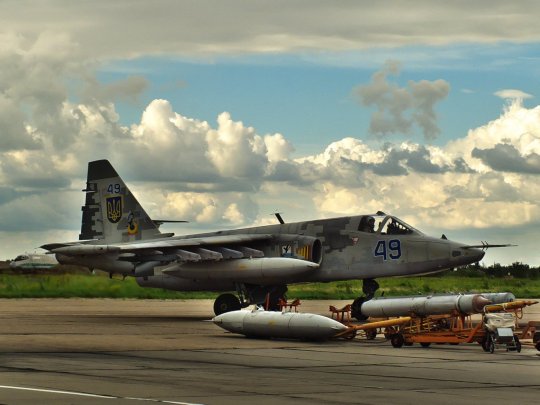
The journalist counted 30 operational Su-25s, one that was undergoing review at the Zaporizhzhia State Aircraft Repair Plant, in addition to another 12 that were stored in Mykolaiv-Kulbakino, the base of the 299ª Brigade in southern Ukraine.
When Russia invaded Ukraine on February 24, 2022, the Su-25 and their pilots and crews spread through Ukraine to dodge Russian missiles - and then went into action, advancing towards Russian forces at extremely low levels to drop bombs and fire rockets.

In the following two years, the Russians slaughtered or exploded 18 Su-25 jets and killed many pilots. But among them, Macedonia and Bulgaria donated to Ukraine the same 18 Su-25. Although it is possible that the 299ª Brigade stripped some of the donated fuselages to obtain spare parts, it is also possible that the unit cannibalized the former Soviet former Sukhois - and put the donated jets into action.
All this means that, despite the heavy losses, the 299ª Brigade continues in the fight. It is the same situation in which the other brigades of the Ukrainian Air Force find themselves. Units that fly Sukhoi Su-24 bombers, Sukhoi Su-27 fighters and Mikoyan MiG-29 fighters maintained their strength on the front line by acquiring new jets from abroad - in the case of MiG-29 squadrons - or reactivating old stored jets.
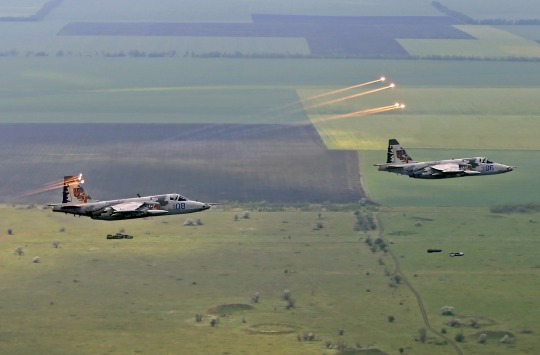
Still, the Ukrainian authorities seem to understand that there is no longer an abundance of Su-25 in excess in the arsenals of the allied countries. Any additional losses could harm the force of the 299ª Brigade.
Therefore, it should come as no surprise that General Oleksandr Syrsky - former head of the ground forces, now head of all armed forces - has his heart turned to the American A-10. The A-10 twin-engine subsonic is largely similar to the Su-25. In fact, it is better protected and much better armed.
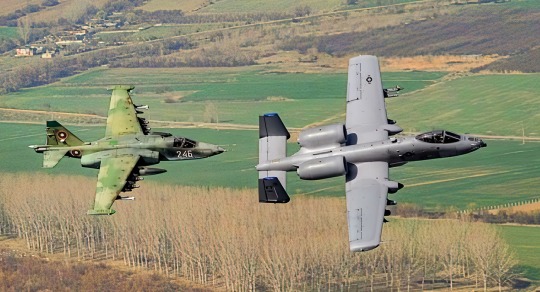
USAF A-10 flies along a Su-25 from Bulgaria.
“This is not a new machine,” Syrsky said of the A-10, “but a reliable machine that has proven itself in many wars and that has a wide range of weapons to destroy land targets to help the infantry.”
The U.S. Air Force operated about 200 A-10 jets from the 1970s and 1980s. Hundreds of others are stored. There is no reason why, after a few months of training, Ukrainian pilots could not pilot the resistant attack jets.

Rendering of an A-10 in the same pattern as a Ukrainian Su-25.
But there are political reasons why the 299ª Brigade never gets the A-10. Since last autumn in the northern hemisphere, Republicans aligned with Russia in the US Congress have refused to vote on any additional aid to Ukraine: aid that could provide Ukrainians with ammunition, armored vehicles, artillery and - yes - warplanes.
Therefore, the 299ª Brigade must settle for its approximately 40 Su-25 jets - or queue up to receive new jets from any donor other than the United States. Say, Lockheed Martin F-16 from Norway, the Netherlands and Denmark or, potentially, Dassault Mirage 2000 from France.
Source: Forbes
Tags: A-10 Thunderbolt IIMilitary AviationUkraine Air ForceSu-25 FrogfootWar Zones - Russia/Ukraine
Sharing
tweet
Fernando Valduga
Fernando Valduga
Aviation photographer and pilot since 1992, he has participated in several events and air operations, such as Cruzex, AirVenture, Dayton Airshow and FIDAE. He has works published in specialized aviation magazines in Brazil and abroad. He uses Canon equipment during his photographic work in the world of aviation.
Related news
MILITARY
Philippines close to closing deal to buy 12 to 14 Gripen fighters
17/02/2024 - 16:30
MILITARY
India will spend $3.5 billion on planes to increase the surveillance capacity of the Indian Navy
17/02/2024 - 16:00
MILITARY
Ukraine claims to have shot down three Russian jets, two Su-34 and one Su-35
17/02/2024 - 12:10
MILITARY
India's attempt to sell Tejas jets to Argentina receives new impetus
16/02/2024 - 20:00
ARMAMENTS
Italy will buy more StormBreaker bombs and AMRAAM missiles for its F-35 fighters
16/02/2024 - 16:00
The first C-130J-30 Hercules of the Royal Air Force of New Zealand to leave the Lockheed Martin production line in Georgia, USA. (Photo: RNZAF)
MILITARY
VIDEO: New Zealand's first new C-130J-30 Super Hercules leaves the painting hangar
16/02/2024 - 13:00
9 notes
·
View notes
Text
By BARETANG BICOLNON
Barangay Councilor Eddie Berania, 58, was found dead hours after elements of 22nd Infantry Battalion (IB) of the Philippine Army (PA) visited him in barangay San Juan Daan, Bulan, Sorsogon, February 25, according to Karapatan Sorsogon report.
Before the incident, Karapatan Sorsogon explained that Eddie’s family witnessed when a certain Ronnie ‘Tatang’ Albao went to talk to Eddie with the elements of the 22nd IB PA on the same day, February 25 around 6:00 in the morning.
“Eddie’s daughter believed it was suicide, triggered by the non-stop threats against his father. Eddie often tells his family why the soldiers are harassing him despite being a barangay official and he knows nothing about the allegations and what the soldiers are looking for in the area,” said Karapatan Sorsogon.
According to the rights group in the province, the threats to Eddie’s life started in 2022, led by Tatang Albao, a civilian and resident of the neighboring barangay, Brgy. Beguin, Bulan.
“Tatang Albao is also a farmer who was forced to surrender to the AFP and now serves as an accomplice in military operations. The military was forcing Eddie to surrender as an NPA even though he is a civilian and actively serves the barangay as an officer,” the rights group added.
“This new incident in the Bicol region clearly shows that Marcos Jr. administration is not after genuine peace in the country. The peace and order head of the barangay was completely silenced by his soldiers so that they could freely sow terror and threats to other residents in the area,” Karapatan Sorsogon expressed.
2024 Feb. 29
5 notes
·
View notes
Text
On Friday March 22, a video circulated of TNI (Indonesian military) soldiers torturing of a civilian in Papua. In the video, the victim is submerged in a drum filled with water with his hands tied behind his back. The victim was alternately beaten and kicked by the TNI members. The victim's back was also slashed with a knife.
The video circulated quickly and was criticised by a number of parties. Gustav Kawer from the Papua Association of Human Rights Advocates (PAHAM) condemned the incident and called for the perpetrators to be brought to justice. This was then followed by National Human Rights Commission (Komnas HAM), Indonesian Human Rights Watch (Imparsial), the Diocese, the church and students.
Meanwhile, Cenderawasih/XVII regional military commander (Pangdam) Major General Izak Pangemanan tried to cover up the crime by saying it was a hoax and the video was a result of editing. This argument was later refuted by the TNI itself and it was proven that TNI soldiers were the ones who committed the crime.
The torture occurred on February 3 in Puncak Regency, Papua. The victim who was seen in the video was Defianus Kogoya, who had been arrested along with Warinus Murib and Alianus Murib. They were arrested and accused of being spies for the West Papua National Liberation Army-Free Papua Organisation (TPNPB-OPM), a cheap accusation which the TNI and police were subsequently unable to prove at all.
The three were arrested when the TNI was conducting a search in Amukia and Gome district. When Warinus was arrested, his legs were tied to a car and he was dragged for one kilometre, before finally being tortured. Alianus meanwhile was also taken to a TNI post and tortured. After several hours, they were finally handed over to a police post because there was not enough evidence to prove the TNI's accusations.
Defianus finally fainted, while Warinus died of his injuries. Warinus' body was cremated by the family the next day on February 4. Defianus meanwhile is still suffering and remains seriously ill. This is a TNI crime in Papua.
But that's not all. On February 22, 2022, the TNI also tortured seven children in Sinak district, Puncak. The seven children were Deson Murib, Makilon Tabuni, Pingki Wanimbo, Waiten Murib, Aton Murib, Elison Murib and Murtal Kurua. Makilon Tabuni died as a result.
On August 22, the TNI murdered and mutilated four civilians in Timika. They were Arnold Lokbere, Irian Nirigi, Lemaniel Nirigi and Atis Tini. The bodies of the four were dismembered: the head, body and legs were separated into several parts, put in sacks then thrown into a river.
Six days later, soldiers from the Infantry Raider Battalion 600/Modang tortured four civilians in Mappi regency, Papua. The four were Amsal P Yimsimem, Korbinus Yamin, Lodefius Tikamtahae and Saferius Yame. They were tortured for three hours and suffered injuries all over their bodies.
Three days later, on August 30, the TNI again tortured two civilians named Bruno Amenim Kimko and Yohanis Kanggun in Edera district, Mappi regency. Bruno Amenim ended up dying while Yohanis Kanggun suffered serious injuries.
On October 27, three children under the age of 16 were tortured by the TNI in Keerom regency. They were Rahmat Paisel, Bastian Bate and Laurents Kaung. They were tortured using chains, coils of wire and water hoses. The incident occurred in the Yamanai Village, Arso II, Arso district.
On February 22, 2023, TNI personnel from the Navy post in Lantamal X1 Ilwayap tortured two civilians named Albertus Kaize and Daniel Kaize. Albertus Kaize died of his injuries. This crime occurred in Merauke regency, Papua.
Between 2018 and 2021 Amnesty International recorded that more than 95 civilians had been tortured and killed by the TNI and the police. These crimes target indigenous Papuans, and the curve continues to rise year by year, ever since Indonesia occupied Papua in 1961.
These crimes were committed one after another without a break, and followed the same pattern. So it can be concluded that these was not the acts of rogue individuals or one or two people as the TNI argues to reduce their crimes to individual acts.
Rather, they are structural (systematic) crimes designed to subdue the Papuan nation, to stop all forms of Papuan resistance for the sake of the exploitation and theft of Papua's natural resources.
The problems in Papua cannot be solved by increasing the number of police or soldiers. The problems in Papua must be resolved democratically. This democratic solution must include establishing a Human Rights Court for all perpetrators of crimes in Papua since the 1960s, and not just the perpetrators in the field, but also those responsible in the chain of command.
Only this will break the pattern of crimes that are occurring and provide justice for the Papuan people. A Human Rights Court will also mean weakening the anti-democratic forces that exist in Indonesia and Papua, namely military(ism).
A prerequisite for achieving democratisation is to eliminate the old forces, the garbage of history. The cleaner the process is carried out, the broader and deeper the democracy that can be achieved. This also includes the demands of the Papuan people to be given the right to determine their own destiny.
This is not a task for some later day, but is the task of the Papuan people today. Nor is the task of the United Liberation Movement for West Papua (ULMWP) political elite or political activists alone, but it is the task of all Papuan people if they want to extract themselves from the crimes of the TNI and police or Indonesian colonialism.
Independence can only be gained by the struggle of the ordinary people themselves. The people must fight, the people must take to the streets, the people must build their own ranks, their own alternative political tool, and fight in an organised and guided manner.
References
1. Gemima Harvey's report The Human Tragedy of West Papua, January 15, 2014. This reports states that more than 500,000 West Papua people have been slaughtered by Indonesia and its actors, the TNI and police since 1961. The full report can be read at https://thediplomat.com/2014/01/the-human-tragedy-of-west-papua/.
2. Veronica Koman, upload on the chronology of torture of civilians in Papua. Posted on the Veronica Koman Facebook wall, Sunday, March 24, 2024. Accessed via: https://www.facebook.com/share/p/eDBJMeT9wS1MyA6T/?mibextid=qi2Omg on March 25, 2024, 13:00 WIB.
3. Jubi, Alleged torture of citizens by the TNI adds to the long list of violence in the land of Papua. March 23, 2024. Accessed via: https://jubi.id/polhukam/2024/dugaan-penyiksaan-warga-oleh-prajurit-tni-menambah-panjang-daftar-kekerasan-di-tanah-papua/ on March 25, 2024, 14:00 WIB.
4. VOA Indonesia, Amnesty International: 95 civilians in Papua have been victims of extrajudicial killings. Accessed via: https://www.voaindonesia.com/a/amnesty-international-95-warga-sipil-di-papua-jadi-korban-pembunuhan-di-luar-hukum-/6494380.html on March 21, 2022, 15:00 WIB.
4 notes
·
View notes
Text
GUR Chief Kyrylo Budanov stated in an interview with Forbes that the Russian offensive is so ineffective as to be almost unnoticeable and noted that Russian forces have been rationing shells and ammunition to sustain assaults on the Bakhmut, Lyman, and Vuhledar directions while conserving shells in other areas. Budanov's statement coincides with ISW's assessment that Russian forces are prioritizing the Bakhmut and Lyman directions and have yet to launch a significant push to advance in areas west of Donetsk City. Budanov added that Russian artillery stocks decreased to 30 percent of the total number of shells. He claimed that Russia has imported a test batch of artillery shells from Iran and is currently attempting to procure another batch of 20,000 shells. Budanov previously estimated that Russian forces fired about 20,000 shells per day in late December 2022, down from 60,000 shells per day during the early stages of the war. Budanov also observed that Russian tactics around Bakhmut and Vuhledar have largely shifted from artillery and mechanized attacks to infantry assaults due to the lack of shells and armored vehicles. Budanov noted that Russia had committed more than 90 percent of its 316,000 mobilized personnel to the frontlines, which further confirms Western and ISW's assessments that Russian forces do not have significant untapped combat-ready reserves. Budanov noted that the Kremlin's stated objective of producing 800 tanks per year is unrealistic and stated that Russia can only produce 40 cruise missiles per month, which they use up in a single round of missile strikes. Russia has already lost at least 1,500 tanks and possibly as many as 2,000, as ISW has previously reported.
tfw you can't even feel their assault
37 notes
·
View notes
Text
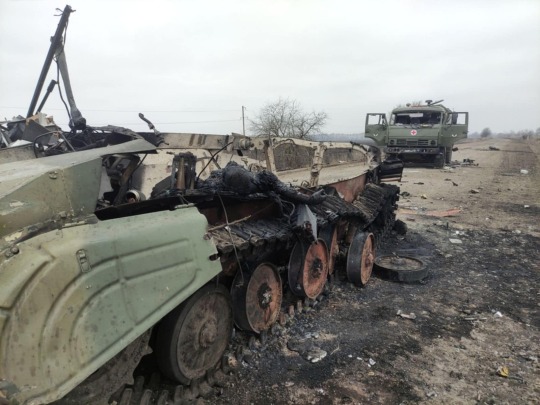

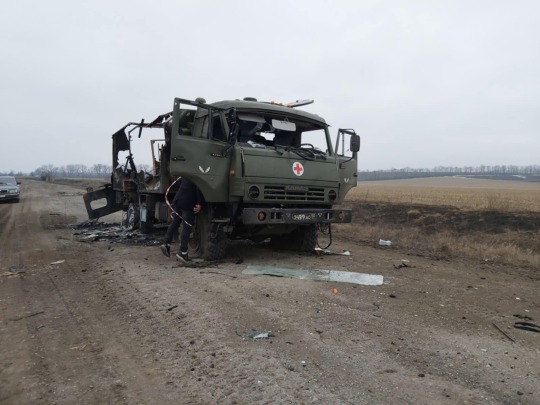

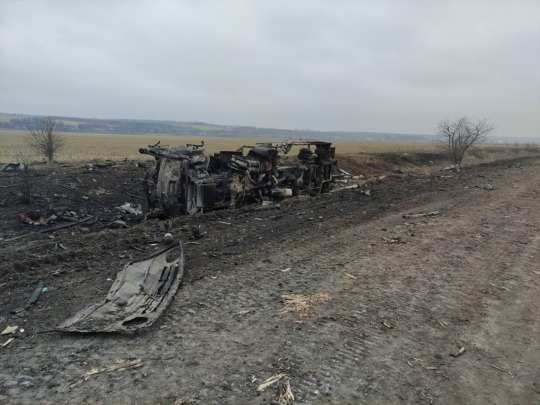
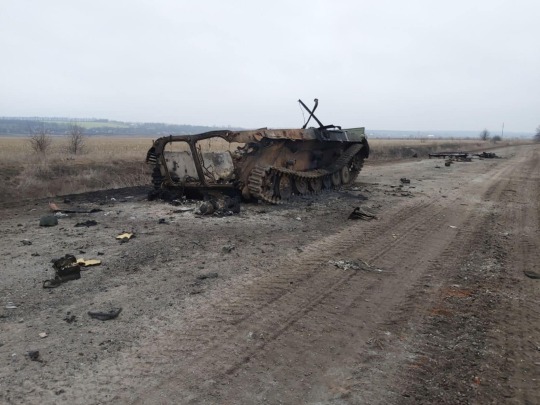
Destroyed Russian army column with burnt BMP infantry fighting vehicles, dead Russian troops and KAMAZ military trucks, Ukraine, 2022/2023. Source: Микола Задорожній
P.S. New and new photographic evidence of the huge losses of the Russian army in Ukraine comes in every day. In fact, many Western media are reluctant to admit that the Russian army is not as powerful as they tried to make it out to be by spreading Kremlin propaganda.
In fact, the Russian attack on Ukraine became possible only because the West invested almost nothing in the security of Eastern Europe under the pretext of business and "peacekeeping interests". Many Western politicians and "experts" hoped that Russia was strong and that Ukraine would not be able to resist. They planned and still plan to conclude a "separate peace" with the Kremlin at the expense of the security of Eastern Europe...
#Ukraine#russian invasion#russian defeat#russian losses#ukrainian independence war#BMP-2#infantry fighting vehicle#rural landscape#military history#defense of liberty#russian armor
14 notes
·
View notes
Text
The director of Jenin Hospital announced that two martyrs and three injuries were administered to the hospital after Israeli occupation forces shelled the al-Ansar Mosque in the Jenin refugee camp in the occupied West Bank.
The Israeli occupation army confirmed that a fighter jet had targeted the mosque and its surroundings at around 2 a.m. on Sunday.
The airstrike against the al-Ansar Mosque coincided with reports of Israeli infantry units being deployed at the camp's entrances, without the exact scale being specified.
The shelling came at a time when Israeli attacks on Palestinians in the West Bank and the occupied territories in 1948 are escalating, parallel to the continued criminal bombing of civilians in the Gaza Strip.
Concurrently, Israeli occupation forces stormed the city of al-Khalil and the town of Beit Ummar in the West Bank.
Al Mayadeen's correspondent confirmed that Israeli settlers attacked residents of the town of Huwara, south of Nablus, and opened fire on Palestinian homes.
Additionally, the Ministry of Health announced on Saturday evening the death of 19-year-old Palestinian youth Qassam Farouk Mohammad Haj Ahmad, who succumbed to critical injuries sustained from Israeli gunfire to the head about a week ago in Tulkarm.
Reports by the UN Office for the Coordination of Humanitarian Affairs (UNOCHA) show that Palestinian casualties of settler violence in the occupied West Bank have been sharply increasing over the past three years.
In 2020, 24 Palestinians were killed by settlers or the IOF. It increased by four-fold in 2021 reaching 84. In 2022, the number of Palestinians killed was 154, increasing to 277 in 2023 as of October 20.
Up until September 19, prior to Operation Al-Aqsa Flood, 189 Palestinians were reported to be killed. This number saw a sharp spike since October 7, with 88 Palestinians killed over the span of two weeks.
That is roughly seven Palestinians killed each day in the West Bank aside from large-scale massacres being committed against their brethren in Gaza. The UN has also recorded 102 attacks of settler violence targeting Palestinians and their property in the West Bank in the past two weeks.
5 notes
·
View notes
Text
And the new New Year’s Address (2022 into 2023):
youtube
New Year greetings of President of Ukraine Volodymyr Zelenskyy
Dear Ukrainians!
This year began on February 24. Without prefaces and preludes. Sharply. Early. At 4 o'clock.
It was dark. It was loud. It was hard for many and scary for some. 311 days have passed. It can still be dark, loud, and complicated for us. But we will definitely never be afraid again. And we'll never be ashamed.
It was our year. Year of Ukraine. Year of Ukrainians.
We woke up on February 24. Into another life. Being another people. Another Ukrainians. The first missiles finally destroyed the labyrinth of illusions. We saw who was who. What friends and enemy are capable of, and most importantly, what we are capable of.
On February 24, millions of us made a choice. Not a white flag, but a blue and yellow flag. Not escaping, but meeting. Meeting the enemy. Resisting and fighting.
The explosions on February 24 stunned us. Since then we have not heard everything. And we don't listen to everyone. We were told: you have no other option but to surrender. We say: we have no other option than to win.
On February 24, we began to create our victory. From many bricks – hundreds of other victories.
We have overcome the panic. We did not run away but united. We have overcome doubts, despair, and fear. We believed in ourselves and in our strength. The Armed Forces of Ukraine. Intelligence. National Guard. SBU. Special Operations Forces. Border guards. Territorial defense forces. Air defense forces. The police. The State Emergency Service. All our defense and security forces. I am proud of you all, our warriors!
This year can be called a year of losses for Ukraine, for the whole of Europe, and the whole world. But it's wrong. We shouldn't say that.
We haven't lost anything. It was taken from us. Ukraine did not lose its sons and daughters – they were taken away by murderers. Ukrainians did not lose their homes – they were destroyed by terrorists. We did not lose our lands – they were occupied by invaders. The world did not lose peace – Russia destroyed it.
This year has struck our hearts. We've cried out all the tears. All the prayers have been yelled. 311 days. We have something to say about every minute. But most of the words are superfluous. They are not needed. No explanations or decorations are needed. Silence is needed to hear. Pauses are needed to realize.
The morning of February 24.
Hostomel. Bucha. Irpin. Borodianka. Kharkiv.
Mriya.
Kramatorsk Station. Toy.
Chernihiv.
Mariupol. Drama Theater. The word "Children" written.
Olenivka.
Odesa. Multi-story building. Girl. Three months old.
Vilniansk. Maternity hospital. Baby. Two days old.
Azovstal.
It's impossible to forget. And it's impossible to forgive. But it's possible to win.
We stood on our feet because there was something that kept us going. Our spirit.
Defense of Kyiv.
Kharkiv.
Mykolaiv.
Chornobayivka.
Snake Island.
HIMARS.
Antonivsky Bridge.
"Cotton" pops.
Crimean Bridge.
Neptune.
Cruiser Moskva.
Russian warship.
Izyum, Balakliya and Kupyansk.
Kherson.
And we pray that there will be Kreminna and Svatove, Melitopol, all of Donbas, Crimea.
We fight and will continue to fight. For the sake of the main word: "victory."
It will be for sure. We are approaching it for 311 days.
We gave it a lot of strength. But at the moment, when it seems that you can't go any further, remember that we have already passed with you.
I want to say to all of you: Ukrainians, you are incredible! See what we have done and what we are doing!
How our soldiers have been smashing this "second army of the world" since the first days.
How our people stopped their equipment and infantry columns.
How an old man used his hands to stop a tank.
How a woman knocked down a drone with a jar of tomatoes.
How enemy tanks, armored personnel carriers, helicopters, shells were stolen during the occupation.
How we fundraised for Shahed hunters, naval drones, armored vehicles, ambulance vehicles and Bayraktar drones in several hours.
How we withstood all threats, shelling, cluster bombs, cruise missiles, darkness and cold.
How we supported each other and the state.
Everyone is important in war.
Who holds a weapon, the steering wheel of a car, the helm of a ship or plane, a scalpel, or a pointer.
Everyone who is behind a laptop, who drives a combine harvester, a train.
Who is at a roadblock and a power plant.
Journalists and diplomats, utility workers and rescuers.
All. Who is working. Studying at a university or school. And even those who are just learning to walk.
All this is for their sake. Our children. Our people. Our country.
There are no small matters in a great war. There are no unnecessary ones. Each of us is a fighter. Each of us is a front. Each of us is the basis of the defense.
We fight as one team – the whole country, all our regions. I admire you all. I want to thank every invincible region of Ukraine.
Kharkiv. Mutilated but unconquered. You proved to the enemy that being close territorially does not mean being close in mind. Kharkiv is a Ukrainian city. The hero city.
Invincible Mykolaiv. Heroically withstands all blows. The city on a wave that overcomes all storms.
Sumy city and the region. You were one of the first to feel the full-scale invasion of the invaders. Sumy region became a bone in their throat for them. Ordinary people made Molotov cocktails, burned enemy columns, took the first prisoners. Sumy region is a force.
Dnipro. The support and reliable rear of our front. You received people, you got the lives of wounded soldiers back. Despite constant barrages, Dnipro lives on.
Odesa. Sunny and friendly, now a fortress. World fortress. Which defends us and which defends the world. Feeds it by sending millions of tonnes of salvation by sea every day. Because it is Odesa Mama.
Kherson! You are heroic people! You have been under occupation for more than eight months. No news. No communication. Separated from Ukraine.
Thousands of you took part in actions against the ruscists. You did not know whether we saw it in Ukraine or knew about it. The occupiers lied to you that Ukraine abandoned you and would not fight for you. But you believed and waited despite everything. The face of Kherson is cut by fragments of shells, but the main thing is that we welcome the New Year free and together under blue and yellow flags. And therefore, we will restore everything, rebuild everything. Just like Chernihiv and Zaporizhzhia, and Kramatorsk, and Bakhmut.
Those that became a refuge for millions of Ukrainians: Rivne, Ivano-Frankivsk, Ternopil, Vinnytsia. I thank you! Those who receive and transfer millions of tonnes of aid from Europe and the world: Lviv, Uzhgorod, Chernivtsi, Lutsk. Thank you! Those who accept the evacuation of businesses, enterprises, universities: Khmelnytsky, Zhytomyr, Kropyvnytsky, Poltava, Cherkasy. Thank you!
And those who are waiting for Ukraine. And will wait. Donbas, Luhansk region, Crimea. Thanks to you, our warriors!
And, of course, Kyiv region and the city are our heart, which always beats thanks to you, all our Ukrainians!
We are all one family. One Ukraine.
This is the year when Ukraine changed the world. And the world discovered Ukraine. We were told to surrender. We chose a counterattack! We were told to make concessions and compromises. We are joining the European Union and NATO.
The world heard Ukraine. European Parliament, Bundestag, the UK Parliament, Knesset, the US Congress.
The world felt Ukraine. Ukraine in the media. In the hearts of people. At the top of Google search.
The world saw Ukraine. On the main squares in Toronto, New York, London, Warsaw, Florence, Sydney, and other cities.
Ukrainians surprise. Ukrainians are applauded. Ukrainians inspire.
Is there anything that can scare us? No. Is there anyone who can stop us? No.
Because we are all together.
It is what we are fighting for. One for each other.
The best salute for us is at the warehouses of the occupiers. The best gift is the numbers in the report of the General Staff.
We do not know for sure what the new year 2023 will bring us. But ready for anything.
New achievements? We will be happy. New hits? We will be steadfast. Continuation of the fight? We will fight. And when we win, we will hug.
Dear Ukrainians!
A few minutes remain until the New Year. I want to wish all of us one thing – victory. And that's the main thing. One wish for all Ukrainians.
Let this year be the year of return. The return of our people. Soldiers – to their families. Prisoners – to their homes. Immigrants – to their Ukraine.
Return of our lands. And the temporarily occupied will become forever free.
Return to normal life. To happy moments without curfew. To earthly joys without air alerts.
The return of what has been stolen from us. The childhood of our children, the peaceful old age of our parents.
So that grandchildren come to visit their grandparents during the holidays. To eat watermelons in Kherson. And the cherry in Melitopol.
So that our cities are free. Our friends are faithful.
And so that our main figure and main success appeared in reports near the figure of 100,000 destroyed enemies, thousands of units of destroyed Russian equipment – it is 603,628 square kilometers. The area of independent Ukraine, as it was since 1991. As it will always be.
May the New Year bring all this. We are ready to fight for it. That's why each of us is here. I'm here. We are here. You are here. Everyone is here. We are all Ukraine.
Glory to Ukraine!
Happy New Year!
Source:
https://www.president.gov.ua/en/news/novorichne-privitannya-prezidenta-ukrayini-volodimira-zelens-80197
#again#really emotional#volodymyr zelenskyy#volodymyr zelensky#Ukraine#new year#also#a lot of very good points#Youtube
24 notes
·
View notes
Photo






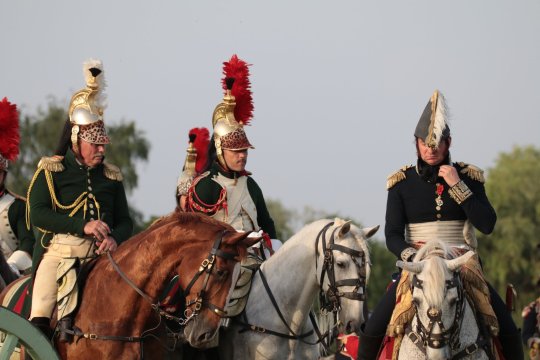

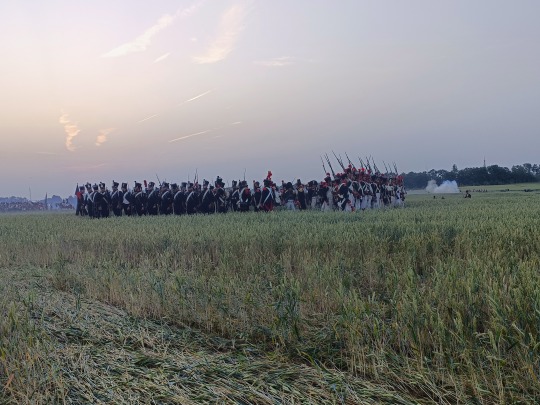

Waterloo 2022
On thursday 16th june I travelled to Waterloo to take part in the Waterloo battle. I played the part of a fusiler soldier in the 85é regiment with the original banner flying from our part of the French bivac. On the first day we just spent the time building up the camp and setting everything in place, the temperatures were comfortable enough to go and explore the battlefield and its numerous monuments.
Most of the reenactors arrived on friday so the camp, which started from just a few tents, grew into a proper large camp. There were three camps in total: The French bivac, us, we stayed over in the vineyard behind Napoleon’s last headquarters. The allies camp was located at Hougemont farm and the civilian camp just beside the Lion of Waterloo. On friday we had our first military drills, we were also woken up every morning at 7:00 with the trumpet blowing the reveille. Life in bivac consists of drills, cleaning weapons, making cartouches, and of course camping without any modern equipment or electricity. Our regiment slept in tents, the picture with the tent and shako was mine. One regiment from Germany went full hardcore and slept on the ground on just a strawbed underneath the stars but the weather was incredibly hot so that might have been a good idea after all.
During the friday evening I did get a bit drunk with a group of Italians, I am myself from the Netherlands. We wandered to the spot where Napoleon’s tent was located and we saw him chatting with a few of his marshalls accompanied with his mameluk bodyguard. We all cheered: Vive l’Empereur! as loudly as we could which drew his attention to us as he greeted us. I felt bold enough to ask for a selfie with the emperor which he was happy to do so when I got my picture and a hug even, all the marshalls wanted to be on the photo with him as well. Napoleon was played by the wonderful Max Schneider who is just an exact clone of the real Napoleon, same height, same eye colour, same hair and the exact same behaviour and mannerisms, he was perfect in character for the entire event. I pretty much got drunk that night just celebrating with people from all over Europe until 4:00 in the morning so I didn’t get any sleep at all.
On Saterday we knew it was going to be very hot, 35 degrees in the full sun with barely any shadow in the French bivac, the allies had more fortune since they had a lot of trees providing shadow. The military drills were pushed forward in the morning because of the heat so I was standing in full uniform at 10:00 in the morning to drill, our regiment was attached to three other regiments with one commanding officer, Leclerc, we did some weapon drills and planned our movements for the battle later this day. The battle itself was set for the evening because it was simply too hot during the midday. The original plan was to march the 7km to the battlefield in full uniform but due to the heat, the staff of the event hired tour buses with airco to take us to the battlefield, just imagine the sight of several tour busses full with fully armed Napoleonic soldiers and weapons, it was a very weird sight as we were escorted by the Belgian police to the battlefield.
The battle itself was incredible and very tiresome as it was still over 30 degrees celcius. We marched onto the field and took our position as Napoleon rode past us giving us a speech, we all raised our muskets and yelled vive l’empereur! as he went past us, the atmosphere I felt then was just absolutely amazing. The French artillery fired the first canon shots opening the battle which lasted about 2 hours. Of course we all know how the battle ended but near the end of the battle, Napoleon returned trying to motivate us to fight even harder. One of the British canon shots went a little bit wrong and part of the cartouche landed right in front of the public stands in the grass which caused a lot of dirt to kick up while the audience screamed. At the end of the battle all of the French infantry we formed a giant square while Napoleon rode around us giving us one final speech, we cheered and screamed while we once again took on the English. Unfortunately we eventually all had to retreat and thus the battle ended. The Belgian police was there proving us with water as well since the temperatures were still scorching.
We arrived back at our bivac at 22:30 but most of us were so tired from the heat, the barely amount of sleep of the previous two nights and the knowledge that we had to march to battle once more at 07:00 in the morning so we slept a little earlier. Fortunately, the winds changed so the temperature dropped to just 14 degrees but this sudden drop caused most of us to wake up shivering in our tents at 3:00 in the night. On sunday morning we marched towards the battlefield which was much more managable thanks to lower temperatures and played the battle again. This time our regiment acted as voltigeurs so we could play as light infantry. We spread out on the right flank trying to outflank the British 95th rifles, we bayonet charged them which was a lot of fun. The second battle also lasted 2 hours and believe me, after 4 hours of battle and several more of drilling, you can barely feel your muscles anymore.
After the battle we went back to our bivac again and with normal temperatures I decided to explore a few museums there, while being in uniform I gained entrance to all the places for free and I was asked a lot by the visitors if they could take a photograph of me, I found that quite humbling. I visited Napoleon’s last headquarters building, the table where he sat at planning the battle and his field bed. Bought some souvenirs for myself and my mother and drank some fine Waterloo beer. At the end of the day we slowly packed our stuff and went on our way home but not before I stopped at the battlefield and plucked some of the growing corn as a memorial since I marched and fought on the same ground where my 4th great grandfather fought during the actual battle of Waterloo. It was bizare to imagine that around 50,000 people died on the exact spot where I was walking. It was an unforgettable experience and I am already looking forward to next year.
The only downside, I can’t get these French marches out of my head, we sang chanson de l'Oignon at least over 100 times while marching...
Au pas camarades, au pas camarades,
Au pas, au pas, au pas,
76 notes
·
View notes
Text
Daily Wrap Up March 7, 2023
Under the cut:
Ukraine and Russia have exchanged prisoners of war in another swap, announced by both sides on Tuesday. Moscow said it had been able to return 90 servicemen from territory controlled by Kyiv, whereas Ukraine said it had been able to bring back 130 of its soldiers from Russian captivity.
Serhiy Hayday, head of the Luhansk region military administration, says the situation "is difficult [in the Luhansk region] but controlled by the Defense Forces of Ukraine." He said on Ukrainian television that "the most difficult areas are Bilohorivka and Kreminna" where there were constant assaults and shelling by Russian troops.
The Ukrainian deputy prime minister told regional media on Tuesday that fewer than 4,000 civilians, including 38 children remain in Bakhmut.
New intelligence reviewed by U.S. officials indicates that a pro-Ukrainian group sabotaged the Nord Stream pipelines that carried natural gas from Russia to Europe, but they have found no evidence of Kyiv government involvement in the September 2022 attack, the New York Times reported on Tuesday.
“Ukraine and Russia have exchanged prisoners of war in another swap, announced by both sides on Tuesday.
Moscow said it had been able to return 90 servicemen from territory controlled by Kyiv, whereas Ukraine said it had been able to bring back 130 of its soldiers from Russian captivity.
“Another prisoner swap — we managed to bring home 130 of our people — 126 men and 4 women,” the Ukrainian President’s Chief of Staff Andriy Yermak posted on Telegram on Thursday. “Among them — 87 defenders of Mariupol, 71 of whom are from Azovstal. We are also returning those taken prisoner in the area of Bakhmut and Soledar — 35 people in total from the Donetsk direction.”
“Most of the people we are returning today are seriously injured. As President Volodymyr Zelensky says, the state must take care of each of them. Each of our heroes should feel that the state cares about them,” he added.
Russia's Ministry of Defense also said the soldiers it was able to exchange for were in “mortal danger” and said they’d be flown to Moscow for treatment.
“As a result of the negotiation process, 90 Russian servicemen who were in mortal danger have been returned from the territory controlled by the Kyiv regime,” it said in a statement on Tuesday. “Airplanes of the military transport aviation of the Russian Aerospace Forces will transport the released servicemen to Moscow for treatment and rehabilitation at medical institutions of the Russian Defense Ministry.”
“All those released are being provided with the necessary medical and psychological assistance,” it added.”-via CNN
~
“While most attention is focused on the battle for the city of Bakhmut, fierce battles continue a short distance to the north, according to Ukrainian officials.
Serhiy Hayday, head of the Luhansk region military administration, says the situation "is difficult [in the Luhansk region] but controlled by the Defense Forces of Ukraine."
He said on Ukrainian television that "the most difficult areas are Bilohorivka and Kreminna" where there were constant assaults and shelling by Russian troops.
"They are trying to push out our defenders to reach Stelmakhivka, Nevske, and recapture these settlements."
Stelmakhivka and Nevske are villages on the borders of the Luhansk and Kharkiv regions that were recaptured by Ukrainian forces in September.
"When they [the Russians] lose personnel and their hardware is damaged, they take time to "recover" for about a day, replenish their supplies, and then go on the offensive again," Hayday said.
"There's more shelling now. We can clearly see that they have been given ammunition and supplies recently. That's why the number of attacks with 'heavy' artillery and tank attacks has increased."
Hayday said the Russians were regularly changing their tactics. "There were small groups; there were offensives with up to three companies of exclusively infantry; there was an offensive using "armor" with up to two companies supported by "heavy" hardware."
In that way, the Russians were constantly trying to test the strength of Ukrainian defenses, he said.”-via CNN
~
“The Ukrainian deputy prime minister told regional media on Tuesday that fewer than 4,000 civilians, including 38 children remain in Bakhmut.
“Approximately 38 children, as far as we know, remain in Bakhmut today,” AFP quotes Iryna Vereshchuk saying.
The city, the focus of fierce fighting in the Donbas region, had an estimated prewar population of about 70,000 people.
Volodymyr Zelenskiy has said Ukraine is committed to defending the embattled city despite a partial encirclement, and there are conflicting reports about the state of the defence of the city.
Jan Gagin, an adviser to the Russian-installed leaders in the occupied portion of Donetsk, has claimed that Russian forces control about half of Bakhmut, while Yevgeny Prigozhin, founder of the Wagner mercenary group whose troops are spearheading the attack, has said that between 12,000 and 20,000 Ukrainian troops remain defending it.
Russia’s defence minister, Sergei Shoigu, said on Tuesday the seizure of Bakhmut would allow Moscow’s forces to mount further offensive operations.”-via The Guardian
~
“New intelligence reviewed by U.S. officials indicates that a pro-Ukrainian group sabotaged the Nord Stream pipelines that carried natural gas from Russia to Europe, but they have found no evidence of Kyiv government involvement in the September 2022 attack, the New York Times reported on Tuesday.
The U.S. and NATO have called the attacks, which occurred seven months into Russia's invasion of Ukraine and destroyed three of the four pipelines running under the Baltic Sea, "an act of sabotage".
Moscow has blamed Ukraine's Western supporters and has called on the U.N. Security Council to independently investigate. Neither side has provided evidence.
Citing U.S. officials, the New York Times said there was no evidence that Ukrainian President Volodymyr Zelenskiy or his top aides were involved in the operation or that the perpetrators were acting at the behest of any Ukrainian government officials.
White House spokesperson John Kirby told reporters on Tuesday that Washington was waiting for ongoing investigations in Germany, Sweden and Denmark - all in the Baltic region - to conclude, "and only then should we be looking at what follow-on actions might or may not be appropriate".
Responding to the report, senior Zelenskiy adviser Mykhailo Podolyak told Reuters that the Kyiv government was "absolutely not involved" in the sabotage strike, and had no information about what had happened.
Russia's deputy United Nations ambassador Dmitry Polyanskiy told Reuters the report proved Moscow's push for the Security Council to set up an independent inquiry was "very timely" and it would seek a vote on a draft resolution by the end of March.
The Times wrote that the intelligence review suggested those behind the pipeline explosions, which spewed gas into the Baltic, were Ukrainian or Russian nationals, or a combination of the two, who opposed Russian President Vladimir Putin.
But the review did not specify the members of the group or who directed or paid for the operation, it said.
"U.S. officials declined to disclose the nature of the intelligence, how it was obtained or any details of the strength of the evidence. They have said that there were no firm conclusions about it," the Times added.
Built by Russia's state-controlled Gazprom (GAZP.MM), the Nord Stream gas pipelines connected Russia and Germany. Nord Stream 1 was completed in 2011, and Nord Stream 2 in 2021 - over the objections of Ukraine and some of Germany's allies including the U.S. who feared this would allow Moscow to blackmail Berlin by threatening to curb supplies.
Germany ended up halting certification of Nord Stream 2 amid signs that Russia was about to invade Ukraine, and since then Europe has drastically cut energy imports from Russia.
Gazprom representatives did not immediately respond to a request for comment on the New York Times report.”-via Reuters
14 notes
·
View notes
Text
On Memorial Day 2022, we take a look at the African American origins of the federal holiday established to remember America’s fallen soldiers.
Although May 30, 1868 is cited as the first national commemoration of Memorial Day at Arlington National Cemetery, events lead by African Americans in Charleston, South Carolina to decorate the graves of fallen Civil War soldiers occurred on May 1, 1865, less than a month after the Confederacy surrendered.
Reports of this early version of Memorial Day or “Decoration Day” as it was called, were rediscovered in the Harvard University archives in the late 1990s by historian David Blight, author of the 2018 biography Frederick Douglass: Prophet of Freedom.
To quote from history.com:
When Charleston fell and Confederate troops evacuated the badly damaged city, those freed from enslavement remained. One of the first things those emancipated men and women did was to give the fallen Union prisoners a proper burial. They exhumed the mass grave and reinterred the bodies in a new cemetery with a tall, whitewashed fence inscribed with the words: “Martyrs of the Race Course.”
And then on May 1, 1865, something even more extraordinary happened. According to two reports that Blight found in The New York Tribune and The Charleston Courier, a crowd of 10,000 people, mostly freed slaves with some white missionaries, staged a parade around the race track.
Three thousand Black schoolchildren carried bouquets of flowers and sang “John Brown’s Body.” Members of the famed 54th Massachusetts and other Black Union regiments were in attendance and performed double-time marches. Black ministers recited verses from the Bible.
Despite the size of the gathering and newspaper coverage, the memory of this event was “suppressed by white Charlestonians in favor of their own version of the day,” Blight stated in the New York Times in 2011.
On May 31, 2010, near a reflecting pool at Hampton Park, the city of Charleston reclaimed this history by installing a plaque commemorating the site as the place where Blacks held the first Memorial Day on May 1, 1865.

During the dedication of the plaque, the city’s mayor at the time, Joe Riley, was present to celebrate the historic occasion which included a brass band and a reenactment of the Massachusetts 54th Regiment.
In 2017, the City of Charleston erected yet another sign reclaiming the history and commemorating the event:
“On May 1, 1865 a parade to honor the Union war dead took place here. The event marked the earliest celebration of what became known as “Memorial Day.” The crowd numbered in the thousands, with African American school children from newly formed Freedmen’s Schools leading the parade. They were followed by church leaders, Freedpeople, Unionists, and members of the 54th Massachusetts 34th and 104th U.S. Colored Infantries. The dead were later reinterred in Beaufort.”
To learn more about African Americans’ role in the creation of Memorial Day, check out the links to sources provided in today’s show notes and in the episode’s full transcript posted on goodblacknews.org.
This has been a daily drop of Good Black News, written, produced and hosted by me, Lori Lakin Hutcherson.
For more Good Black News, check out goodblacknews.org or search and follow @goodblacknews anywhere on social.
Sources:
https://www.history.com/news/memorial-day-civil-war-slavery-charleston
https://www.lx.com/black-legacy/dont-overlook-memorial-days-black-southern-roots/53453/
https://www.live5news.com/2020/02/18/charleston-claims-first-memorial-day-celebration-with-african-americans-playing-significant-role/
https://amsterdamnews.com/news/2022/05/28/freed-slaves-started-first-memorial-day-in-the-us/
https://aaregistry.org/story/the-first-american-memorial-day-is-commemorated/
https://www.harlemworldmagazine.com/memorial-day-african-americans-memorial-day-charleston-south-carolina-1865/
#How “Decoration Day” in May 1865#Held by African Americans in South Carolina Led to Memorial Day#freedmen#Black Families#reconstruction#Beaufort S.C.memorial day#memorial day
5 notes
·
View notes
Text
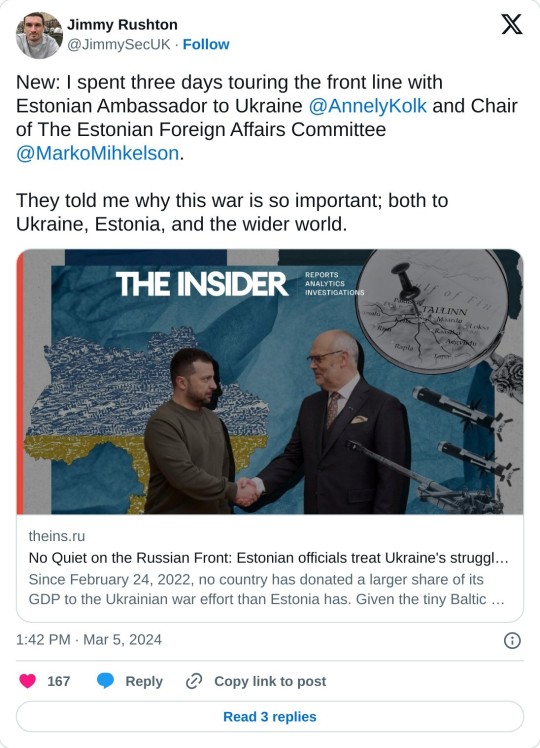
Since February 24, 2022, no country has donated a larger share of its GDP to the Ukrainian war effort than Estonia has. Given the tiny Baltic state’s Soviet-era experience of life under Moscow’s domination, that level of generosity is not difficult to understand. The Insider recently traveled with two high-level Estonian officials on a tour of the front in Ukraine. The experience underscored just how deeply Russia’s other neighbors understand that the failure to properly arm Ukraine is already placing the European Union’s security in jeopardy.
“If all countries did what Estonia was doing, we’d be in Moscow by now,” Mikhail, the commander of a Ukrainian infantry unit currently deployed in Robotyne, told The Insider, only half joking. We’re meeting Mikhail at an undisclosed location to the north of his unit’s positions, roughly 20 kilometers behind the frontline.
It’s one of the last stops on a three-day tour of the front, with The Insider joining Estonia’s Ambassador to Ukraine, Annely Kolk, and Marko Mihkelson, Chairman of the Foreign Affairs Committee of the Estonian Parliament. The trip coincides with what one Ukrainian officer described as the “toughest fighting since the beginning of the full-scale invasion.” As we saw and heard for ourselves, Ukrainian forces are suffering acute ammunition shortages while attempting to hold off an enemy that is stubbornly determined to advance, regardless of the human cost.
The trip has been arranged by a Ukrainian-Estonian group of volunteers, who run the “One Team, One Fight Foundation.'' They’ve been delivering non-lethal military aid to Ukrainian soldiers across the country for nearly two years. The foundation’s director, Dmitro Drey is an affable Ukrainian originally from Luhansk who speaks the heavily accented Russian common for a native of the Donbas region; its co-founder is Harri, an Estonian ex-soldier. Both men have traveled hundreds of thousands of kilometers across Ukraine delivering desperately needed military equipment to frontline units.
Most foreign dignitaries, understandably, will never come as close to the fighting as Drey and Harri do. Many of them would never leave Kyiv or Lviv to travel incognito in inconspicuous, unarmoured vehicles without a security escort. But for both Kolk and Mihkelson, the importance of speaking to Ukrainian troops in person — to get a firsthand understanding of the war — outweighs the not inconsiderable risk. For long periods of time, we were well within Russian artillery range, and the sound of incoming shelling was a disconcerting constant.
For Mihkelson, a reserve officer in the Estonian armed forces, speaking directly to Ukrainian soldiers enables him to better understand the situation on the battlefield, enabling him to be a more effective advocate for the increased provision of Western aid. For Kolk, trips like this one are part of her diplomatic mission. “I’m ambassador to all of Ukraine, not just the capital,” she says. “Sitting in Kyiv gives you an unrepresentative picture of this war.”
And the ambassador is right. Unlike last winter, this year Kyiv has experienced no blackouts and no loss of water supply. The atmosphere on the streets remains relatively calm. If it weren’t for the air attacks — which rarely penetrate the excellent Western-supplied air defense network guarding Ukraine’s largest city — a visitor could be forgiven for forgetting that Kyiv is the capital of a country fighting for its survival.
It’s different in Druzhkovka, 20 kilometers from the battle. Here the sound of artillery is constant, and yet, as in Kyiv, people continue to go about their lives the best they can under the circumstances. A mother and her child walk in a nearby park, while city maintenance workers prune trees. It is a surreal picture. Military aid is distributed to soldiers that have recently come back from their positions in nearby Chasiv Yar, and Kolk and Mihkelson get to hear about the situation in the trenches.
The situation is bleak. Nearly every unit we speak to says that Ukrainian troops are outmanned and outgunned, facing extreme ammunition shortages as they attempt to hold the line against an enemy with an almost suicidal determination to advance.
It’s not difficult to make the direct connection between broken Western promises and the current difficulties on the front line. According to Mihkelson, a lack of Western strategic vision is also to blame. “There’s no clear understanding of how this war should end in Washington or Berlin,” he argues. “We rarely hear that Russia must be defeated on the battlefield.” The constant slow-walking and incremental provision of aid, particularly from the United States, clearly frustrates him. “Why don’t they send some of their own F-16s? They have so many!” Mihkelson says, referring to the American decision not to supply their own fighter jets to Ukraine, instead relying on European allies such as Norway, Denmark, and The Netherlands. “Or the ATACMS missiles that are just sitting in warehouses waiting to be decommissioned.”
The limitations and conditions under which the West has supplied weapons to Ukraine also come in for criticism. In Mihkelson’s words, demands that Kyiv refrain from using Western-supplied weapons to strike targets inside Russia’s internationally recognized borders is akin to asking Ukraine to “fight this war with both hands behind their backs.” It is an opinion commonly shared amongst the Ukrainian troops we spoke to.
As infantry commander Mikhail noted near Robotyne, Estonia’s commitment to the Ukrainian cause stands out. The Baltic country of less than 1.5 million has donated a staggering 3.6% of its GDP in bilateral aid to Ukraine since January 24, 2022, easily the most generous country by this metric (for comparison, the United States has donated 0.32%). “We know this war is existential,” Kolk tells The Insider, explaining Estonia’s high level of support. It is an understanding that permeates every level of the Estonian government. Given the country’s direct experience of Russian imperialism, there is a widespread belief in Tallinn that if Putin is not stopped in Ukraine, Estonia could very well be his next target.
The same is true for Estonia’s neighbors Latvia and Lithuania, both of which have also donated significant amounts of military support to Ukraine while imploring their European and NATO allies to take the threat of further Russian aggression more seriously. For years, the NATO strategy for defending the Baltic states followed the “tripwire” approach — having small numbers of international troops forward deployed to the alliance’s eastern flank not in order to successfully defend against an invasion, but to ensure that any Russian incursion would risk inflicting casualties on British and American active duty personnel, thus bringing the full force of those two military powers into the conflict. But of course, in the event of an actual Russian invasion, the arrival of help from points further west could not have come immediately. “The ‘tripwire’ policy would have left our country occupied by Russian forces,” Mihkelson explains.
The experience of Ukraine under Russian occupation, along with the effectiveness with which Russia has used threats of nuclear “escalation” to delay Western aid deliveries — from the United States and Germany in particular, Mihkelson notes — have led the Baltic States to begin constructing a defensive line of bunkers and fortifications along their countries’ borders with Russia. The importance of Russia not being allowed to quickly take territory, illegally annex it, and then hide behind a nuclear shield is now well understood. Questions of whether an American President would risk nuclear retaliation to support a European NATO ally date back to the Cold War, and the defensive line currently under construction is an attempt to prevent that question from ever having to be answered.
Both Kolk and Mihkelson express frustration at how long it has taken some of Estonia’s allies to appreciate the danger Russia presents to its neighbors. “The West has massively underestimated the threat Russia poses, at all levels,” Kolk argues, paying particular attention to the Kremlin’s information warfare operations. “Here in the Baltics we’ve seen it for years. Russia tries to claim Russian speakers are ‘oppressed’ in our countries, but the truth is Russians living in Estonia have more rights than Russians living in Russia.”
Mihkelson highlights the pattern of Western passivity towards Russia that, in his estimation, led to the current full-scale war in Ukraine. “There seems to be little understanding in many Western capitals that Russia is fundamentally attempting to overturn the current world order,” he says. “This is not only about Ukraine,” he adds, drawing lessons from recent history. “We’ve seen continued weakness in the West’s response to Russia, from the invasion of Georgia, to Obama’s ‘red line’ in response to chemical weapons attacks in Syria. That was clearly a moment when Putin detected weakness.” He notes that, when confronted, Russia has almost always backed down. “We’ve seen so many ‘red lines’ Russia themselves have set down, and then backed away from, when they’ve been crossed,” Mihkelson says.
Towards the end of our tour of the frontline, we arrive at a position close to the town of Orikhiv, north of the highly contested settlement of Robotyne. As we pull up, an M142 HIMARS rolls out towards its firing position. In a testament to the ammunition shortage, only one of its six launch tubes is loaded with a GMLRS rocket. Several groups of Ukrainian soldiers arrive at the meeting point simultaneously. Two young servicemen who hadn’t seen each other for months hug upon realizing that the other is still alive.
Kolk clearly finds the experience emotional. “At that moment I felt I couldn’t hold back tears anymore. My own son is 21,” she says. “I cannot imagine him greeting his friends in such a way.” Except if Estonia’s continuing support for Ukraine demonstrates anything, it is that Kolk, Mihkelson, and hundreds of thousands of other Estonians can all too well imagine that, if Ukraine does not receive the military aid it needs, then the ambassador’s son really could be greeting his friends in exactly the same way in the not-too-distant future.
7 notes
·
View notes